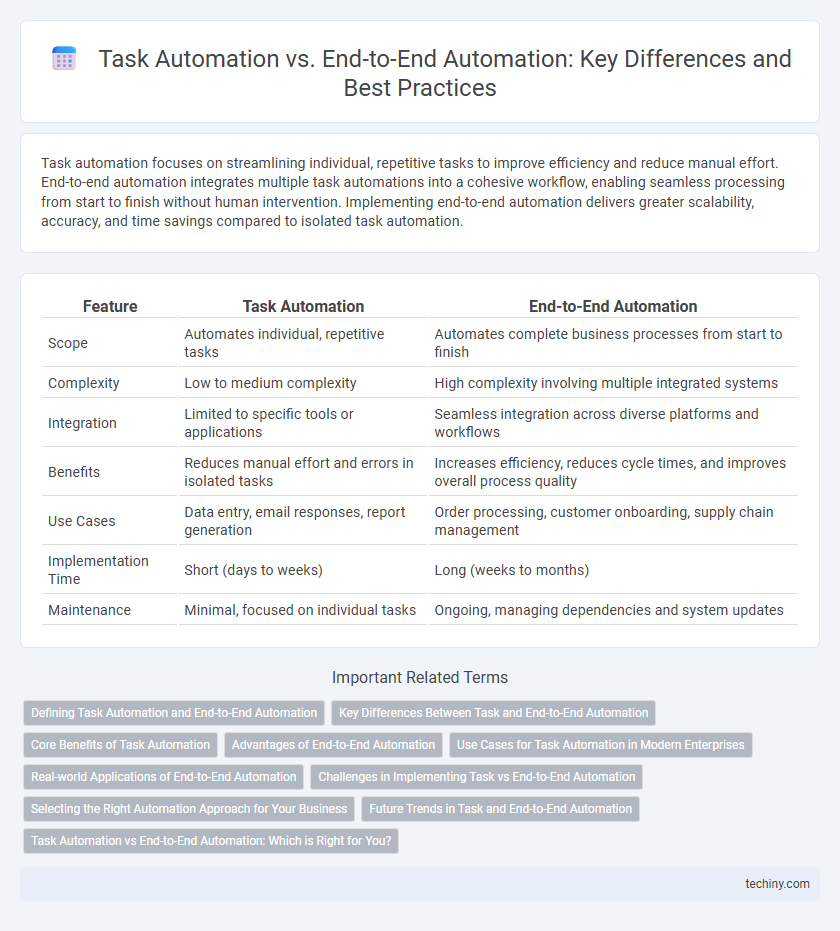Task automation focuses on streamlining individual, repetitive tasks to improve efficiency and reduce manual effort. End-to-end automation integrates multiple task automations into a cohesive workflow, enabling seamless processing from start to finish without human intervention. Implementing end-to-end automation delivers greater scalability, accuracy, and time savings compared to isolated task automation.
Table of Comparison
| Feature | Task Automation | End-to-End Automation |
|---|---|---|
| Scope | Automates individual, repetitive tasks | Automates complete business processes from start to finish |
| Complexity | Low to medium complexity | High complexity involving multiple integrated systems |
| Integration | Limited to specific tools or applications | Seamless integration across diverse platforms and workflows |
| Benefits | Reduces manual effort and errors in isolated tasks | Increases efficiency, reduces cycle times, and improves overall process quality |
| Use Cases | Data entry, email responses, report generation | Order processing, customer onboarding, supply chain management |
| Implementation Time | Short (days to weeks) | Long (weeks to months) |
| Maintenance | Minimal, focused on individual tasks | Ongoing, managing dependencies and system updates |
Defining Task Automation and End-to-End Automation
Task Automation refers to the use of technology to perform specific, repetitive tasks within a workflow, improving efficiency and reducing human error. End-to-End Automation extends beyond individual tasks by automating entire business processes from start to finish, integrating multiple systems and workflows for seamless operation. This holistic approach enhances overall productivity and ensures consistent output across complex processes.
Key Differences Between Task and End-to-End Automation
Task automation focuses on automating individual, repetitive tasks within a specific process, enhancing efficiency and reducing manual effort for discrete activities. End-to-end automation integrates multiple tasks and workflows across systems, creating a seamless process that minimizes human intervention from start to finish. Key differences include the scope of automation, with task automation limited to single activities, while end-to-end covers entire processes, and complexity, as end-to-end automation requires broader integration and orchestration of various systems.
Core Benefits of Task Automation
Task automation streamlines repetitive activities by reducing manual intervention, which significantly boosts operational efficiency and minimizes human error. It enables businesses to allocate human resources toward more strategic initiatives, thereby improving productivity and cost-effectiveness. Core benefits include faster task completion, consistent output quality, and enhanced scalability in handling routine processes.
Advantages of End-to-End Automation
End-to-End Automation streamlines entire workflows by integrating multiple processes into a single, seamless system, reducing manual intervention and minimizing errors. It enhances operational efficiency by providing real-time data visibility and ensuring consistent output quality across all stages. Organizations leveraging End-to-End Automation often experience faster turnaround times and improved scalability compared to isolated Task Automation approaches.
Use Cases for Task Automation in Modern Enterprises
Task automation in modern enterprises streamlines repetitive activities such as data entry, invoice processing, and customer support ticket routing, reducing human errors and freeing up employee time for strategic work. It enhances operational efficiency by integrating with existing software systems like CRM and ERP, enabling faster turnaround and improved accuracy. Common use cases include automating report generation, email responses, and routine compliance checks to support scalable business processes.
Real-world Applications of End-to-End Automation
End-to-end automation streamlines entire workflows by integrating multiple systems and processes, significantly enhancing operational efficiency in industries like manufacturing, finance, and healthcare. Real-world applications include automated supply chain management, AI-powered fraud detection, and patient data processing, reducing manual intervention and errors. This holistic approach enables seamless data flow and decision-making, driving cost savings and faster response times.
Challenges in Implementing Task vs End-to-End Automation
Task automation often faces challenges related to limited scope and integration difficulties, requiring manual intervention between automated tasks that can reduce efficiency. End-to-end automation demands comprehensive system integration, data consistency across platforms, and robust error handling mechanisms, often leading to higher implementation complexity and increased costs. Both approaches require significant change management efforts to align workflows and ensure user adoption throughout the automation lifecycle.
Selecting the Right Automation Approach for Your Business
Task automation targets individual repetitive actions, enhancing efficiency in specific workflows, whereas end-to-end automation integrates multiple tasks into a seamless process, optimizing overall business operations. Selecting the right automation approach depends on factors like process complexity, scalability needs, and cost-effectiveness, ensuring alignment with organizational goals. Analyzing workflow bottlenecks and resource allocation helps determine whether focused task automation or comprehensive end-to-end solutions deliver greater ROI and operational impact.
Future Trends in Task and End-to-End Automation
Task automation will increasingly leverage AI-driven tools to enhance specific workflows, boosting efficiency in isolated processes. End-to-end automation is poised to integrate advanced machine learning, IoT, and cloud computing, enabling seamless, intelligent workflows across entire business operations. Future trends indicate a convergence where task-level automation feeds into comprehensive end-to-end systems that continuously optimize through real-time data analytics and adaptive algorithms.
Task Automation vs End-to-End Automation: Which is Right for You?
Task automation focuses on automating individual, repetitive activities within a process to increase efficiency and reduce human error, while end-to-end automation integrates multiple tasks across the entire workflow to streamline complex processes and boost overall productivity. Businesses seeking quick wins and easy implementation often benefit from task automation, whereas organizations aiming for comprehensive process optimization and scalability prefer end-to-end automation. Choosing between the two depends on factors such as process complexity, budget, and long-term automation goals.
Task Automation vs End-to-End Automation Infographic

 techiny.com
techiny.com